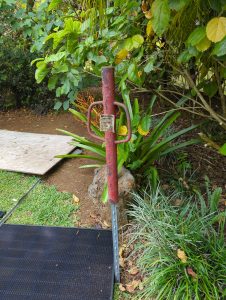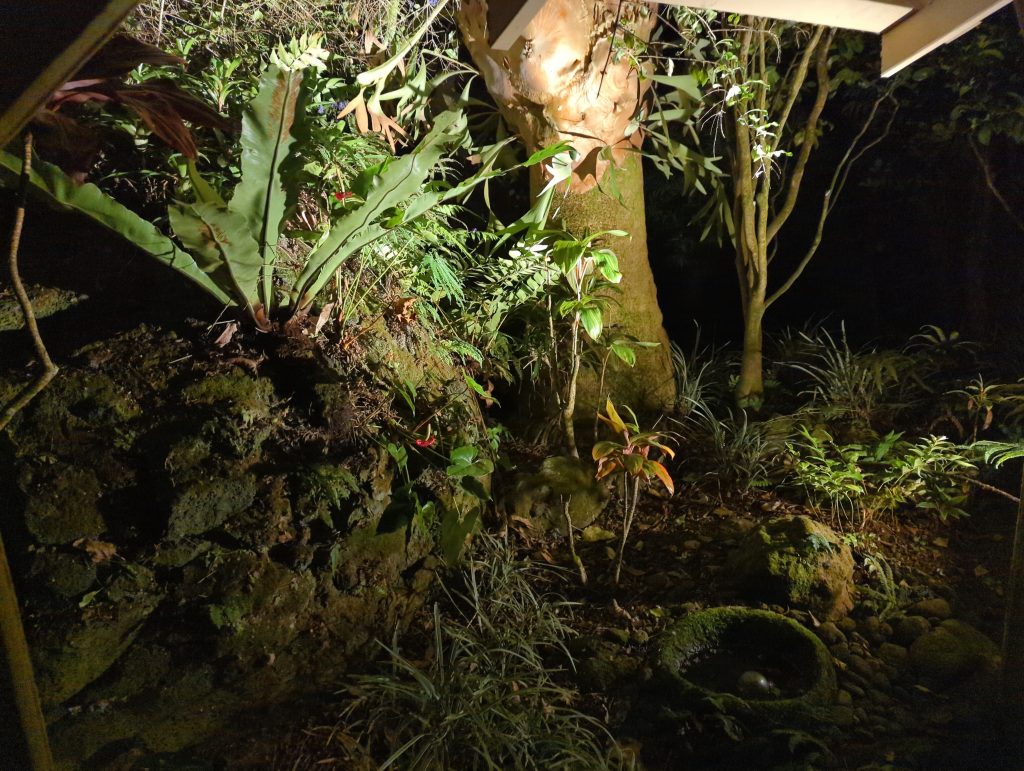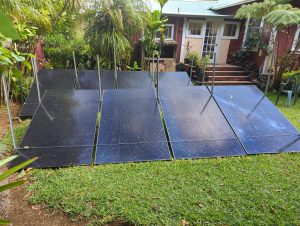 Our new home in Hawai’i is slowly coming together. I expect my current list of projects will take most of a decade to complete, but I can take small steps for now. Eventually, the home will completely eschew the idea of burning anything for energy. Transportation, heating, cooling, cooking, water filtration and heating, garden tools, and the hot tub will all be 100% electric, and the electricity will come from the sun.
Our new home in Hawai’i is slowly coming together. I expect my current list of projects will take most of a decade to complete, but I can take small steps for now. Eventually, the home will completely eschew the idea of burning anything for energy. Transportation, heating, cooling, cooking, water filtration and heating, garden tools, and the hot tub will all be 100% electric, and the electricity will come from the sun.
Right now, my goals are much more modest. The house used to have three very old rooftop panels, but they had to be removed when we replaced the roof. Back in June, we bought eight 400w solar panels but I cleverly broke my wrist and have been unable to install them. As a result, the caretaker has been having to run a gasoline-fired generator every couple of days to keep the batteries charged. It was pretty frustrating to be having to make all the noise and smell and be burning fossil fuels when we had ample solar capacity in a stack in the yard. I tried to get a couple of professional solar installers to set them up, but I seemed to be unable to successfully communicate what I wanted. One installer quoted a minimum of $44,000!
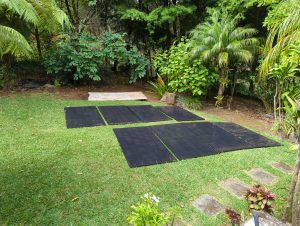 As soon as I thought my hand was healed sufficiently to do the work (turns out I was a bit optimistic), I headed over to the house to do a temporary install of the panels. The caretaker was leaving for a couple of weeks, and they helped me get the panels out of storage. After that, I was to be on my own (by choice, as I had a rather unconventional design and wanted the freedom to tinker with it at leisure).
As soon as I thought my hand was healed sufficiently to do the work (turns out I was a bit optimistic), I headed over to the house to do a temporary install of the panels. The caretaker was leaving for a couple of weeks, and they helped me get the panels out of storage. After that, I was to be on my own (by choice, as I had a rather unconventional design and wanted the freedom to tinker with it at leisure).
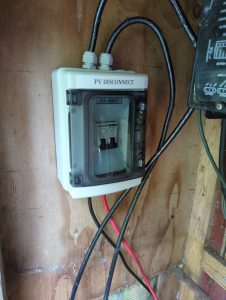 I knew I wasn’t up for a 60-meter trenching job, so I installed the temporary panels next to the inverter, even though they’ll be in shade much of the time. While the panels were still on the ground, I wired them into the existing system. The low-light performance of the Q-Cell panels turned out to be excellent, and provided adequate charging even when the panels were shaded and the weather was overcast.
I knew I wasn’t up for a 60-meter trenching job, so I installed the temporary panels next to the inverter, even though they’ll be in shade much of the time. While the panels were still on the ground, I wired them into the existing system. The low-light performance of the Q-Cell panels turned out to be excellent, and provided adequate charging even when the panels were shaded and the weather was overcast.
The first big setback was when I discovered that I could not yet hold a 4# hammer in my right hand, and even if I supported it with my left, the pain when I actually hit something was excruciating. Since my design was based on using 14 T-posts for support, it seemed unlikely that I would be able to get things installed. I took a time out to consult with a couple of on-site advisors:

 Both advised me to check in the garage where, remarkably, I found a T-post driver. By wearing heavy gloves, I was able to use the driver and get the posts installed.
Both advised me to check in the garage where, remarkably, I found a T-post driver. By wearing heavy gloves, I was able to use the driver and get the posts installed.
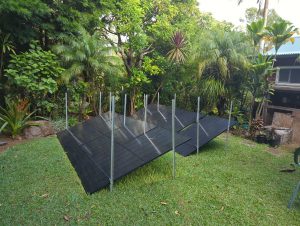 The panels installed without much additional difficulty save for having a shortage of wire rope clips. Remarkably, the tiny local hardware store had some in stock, saving me a rather time-consuming trip to Waimea, the closest town of significant size and an hour-long round trip.
The panels installed without much additional difficulty save for having a shortage of wire rope clips. Remarkably, the tiny local hardware store had some in stock, saving me a rather time-consuming trip to Waimea, the closest town of significant size and an hour-long round trip.
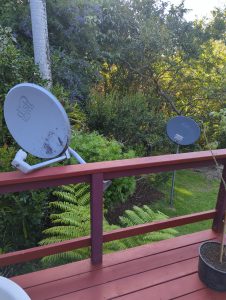
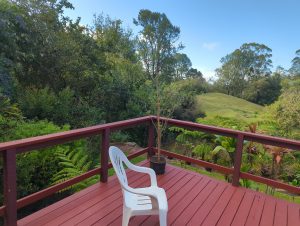 Time for some side projects! There were some left-over satellite dishes for TV and internet. I don’t watch TV, and Hawaii Telcom recent brought gigabit fiber to the property, so I have no need for the dishes. The view is significantly improved.
Time for some side projects! There were some left-over satellite dishes for TV and internet. I don’t watch TV, and Hawaii Telcom recent brought gigabit fiber to the property, so I have no need for the dishes. The view is significantly improved.
Now that I have ample power, I was able to restore some of the outdoor lighting the previous owner had installed to highlight his awesome landscape work. This is the view from the outdoor shower at night:
There’s a lot more to be done, but at least now we can let our lights shine!
Addendum: I’ve had a couple of inquiries about cost. The panels were $2,800 and a set of new AGM batteries were $2,000. The incidentals (wire rope , T-posts, clips, ground rod and wire, connectors, copper wire, and 4:1 parallel branch connectors, turnbuckles, PV disconnect breaker) all came out to somewhat less than $1,000. The inverter and charge controller were salvaged from existing gear. So less than $6,000 plus about three days of my time. It is worth noting that this is a temporary, stop-gap installation that will be changed next year. I was able to take some shortcuts that wouldn’t have worked for a system I expected to be efficient and last 30+ years, and it cannot be directly compared to any of the quotes I got from professional installers.
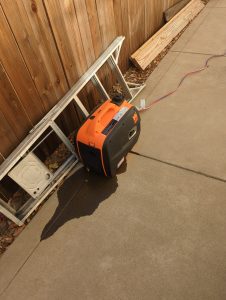 Addendum #2: So I’m back on the mainland having freed the Hawai’i home from the tyranny of the gas generator. Wouldn’t you know it, our local electric utility announced that they had to replace a pole, and power would be out for a day. I have an emergency whole-house propane-fired generator, but it’s a right pain to set up and it’s loud. I have a small unit specifically to keep the server farm alive. I run them both periodically for testing and to keep them fresh, and haven’t had any trouble with them. Wouldn’t you know it, though, this time it wouldn’t start. I ended up having to rebuild the carburetor on my backyard picnic table to keep the farm running.
Addendum #2: So I’m back on the mainland having freed the Hawai’i home from the tyranny of the gas generator. Wouldn’t you know it, our local electric utility announced that they had to replace a pole, and power would be out for a day. I have an emergency whole-house propane-fired generator, but it’s a right pain to set up and it’s loud. I have a small unit specifically to keep the server farm alive. I run them both periodically for testing and to keep them fresh, and haven’t had any trouble with them. Wouldn’t you know it, though, this time it wouldn’t start. I ended up having to rebuild the carburetor on my backyard picnic table to keep the farm running.

